May 22, 2018
Adwords and Bing mirror each other across the board. From expanded ads to being able to import campaigns with nearly identical campaign settings, they make it easy for advertisers to be present nearly simultaneously across multiple search networks. Aside from structure, various tools have also been mimicked.
Today, we are going to take a look at the Adwords opportunities tab (now called “recommendations” in the new experience) and the Bing opportunities tab and provide you with a side-by-side comparison of the features that both offer. Before jumping in, it’s important to keep in mind that every account is different and opportunities that are suggested in either platform need to be carefully analyzed before being implemented. If it’s too good to be true, it probably is. If it didn’t work when you tried it before, it may or may not again. If it’s telling you to spend a million dollars, don’t. You get the point!
Accessibility
(For the sake of the most recent update around the old Adwords interface, we will use the new interface for this post.)
In Adwords, immediately to the right of your list of campaigns, you will find a tab called “recommendations” which was previously called “opportunities” in the old experience.
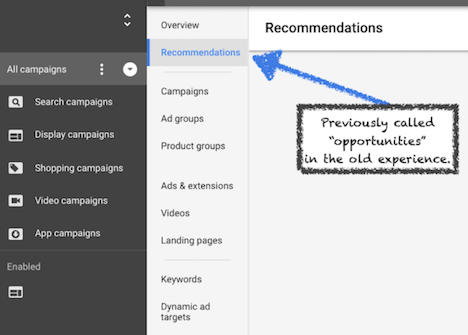
In Bing, on the top menu bar, you will find the tab called “opportunities”.

Winner: In my opinion, Bing wins for ease of finding the opportunities tab, however, Adwords also wins because you are never directed to a separate page but rather the main contents change while the campaign menu and settings menus remain.
Features
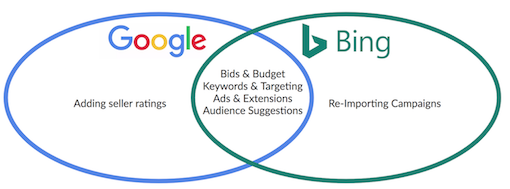
When looking at features, the majority overlap with the exception of Bing’s re-importing campaigns and Adword’s adding seller ratings. Below is a comprehensive list of the opportunities that may be recommended.
- Bid Suggestions
- Keyword bids: Suggestions based on current performance. These can be manual bid adjustments with traffic projections, bids to get on the first page of search results, bids to reach the top of the search results, or bids to increase impression share.
- Bid strategies: Suggestions to test various bid strategizes including maximize clicks, maximize conversions, target CPA etc.
- Device: Suggestions based on the performance of tablet, desktop, and mobile.
- Location: Suggestions based on the performance of specific locations.
- Audiences: Suggestions based on the performance of audiences currently layered with existing campaigns.
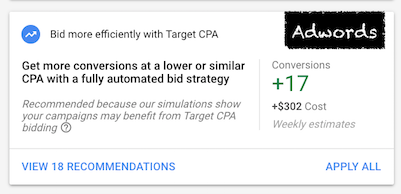
- Budget: Suggestions to increase budgets for campaigns that are currently limited and reaching their daily allocated spend.
- Ad Copy: Suggestions to re-organize campaigns by specific themes.
- Ad Extensions: Suggestions to include ad extensions including seller ratings (Adwords only), callout extensions, sitelink extensions, structured snippets (Adwords only), and call extensions.

- Ad Group Suggestions: Create new ad groups based on keyword themes.
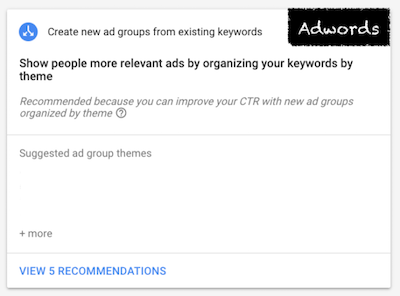
- Keyword Suggestions
- New keywords: New keyword ideas are based on current keywords, landing pages, etc. The suggestions can be in the form of any match type.
- Negative keywords: Suggestions to add negative keywords to prevent your ad from showing when certain keywords are shown.
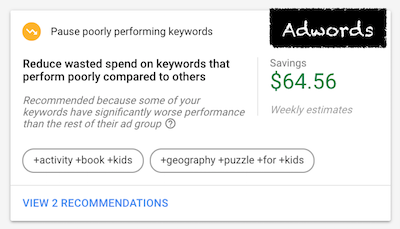
- Audiences: Suggestions to layer additional audiences on top of search, display, or shopping campaigns. This also includes moving ad group level audiences to campaign level for better management.
- (Bing Only) Import Campaigns: Suggestions to re-sync existing Bing campaigns with the Adwords campaigns they were created from.

Winner: Another tie here. Opportunities are nearly identical and only differ when something pertains uniquely to the platform.
Performance Insight
Once you have skimmed through all potential opportunities, you can move forward by selecting “view recommendations” (Adwords) or “view opportunities” (Bing) for any of the listed recommendations. After that, you are shown what the recommendations are, given the option to “apply changes”, and you are shown the estimated performance.
For example, by lowering bids in a limited by budget campaign, Adwords will show estimated weekly clicks, impressions, and cost savings.

In Bing, by adding keywords, Bing will show estimated clicks, impressions, and cost based on a suggested bid.

Winner: In all honesty, with both giving the same performance projections, we have another tie. The only difference being the format of how performance is displayed.
Conclusion
In this case, we have a solid tie when evaluating the opportunities tab.
With the day-to-day management of campaigns, ad groups, and keywords, it’s easy to miss all of the potential optimizations in an account. Both Adwords and Bing provide a comprehensive list of optimizations that can be applied to an account, which gives advertisers options outside of their regular tasks. While opportunities shouldn’t be applied without careful consideration, they can be quick wins. Use your judgment and dive into endless opportunity.
